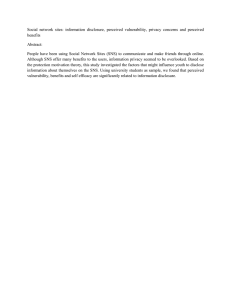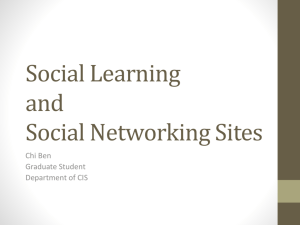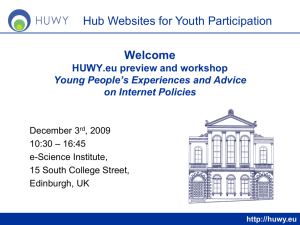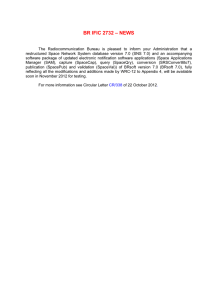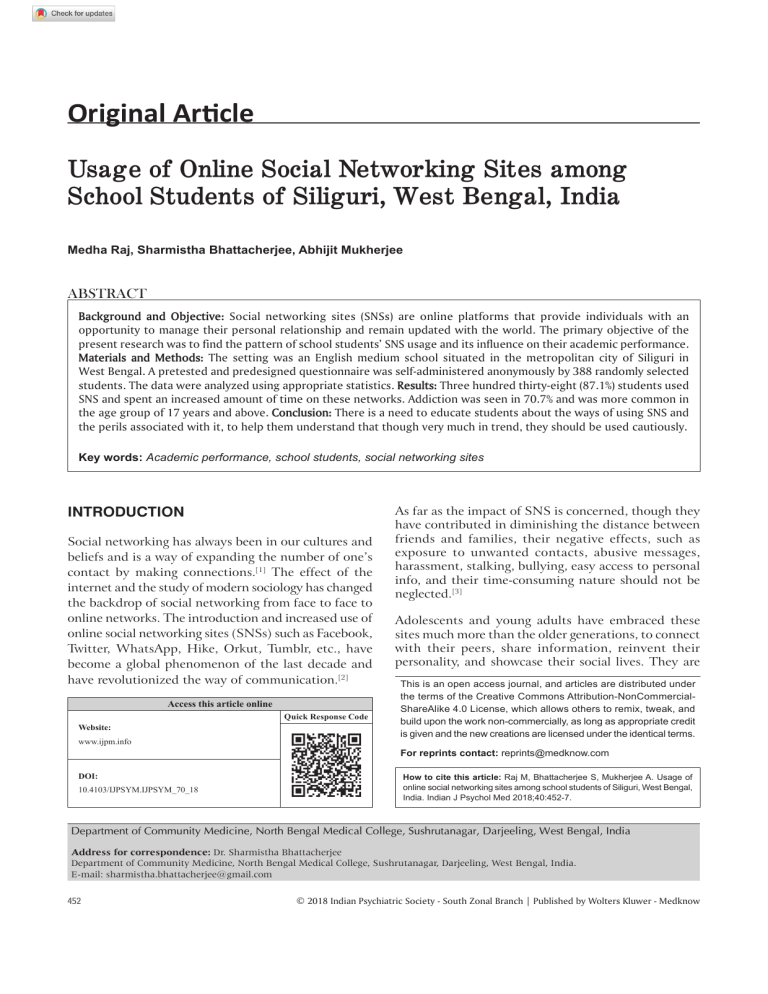
KƌŝŐŝŶĂůƌƟĐůĞ Usage of Online Social Networking Sites among School Students of Siliguri, West Bengal, India Medha Raj, Sharmistha Bhattacherjee, Abhijit Mukherjee ABSTRACT Background and Objective: Social networking sites (SNSs) are online platforms that provide individuals with an opportunity to manage their personal relationship and remain updated with the world. The primary objective of the present research was to find the pattern of school students’ SNS usage and its influence on their academic performance. Materials and Methods: The setting was an English medium school situated in the metropolitan city of Siliguri in West Bengal. A pretested and predesigned questionnaire was self-administered anonymously by 388 randomly selected students. The data were analyzed using appropriate statistics. Results: Three hundred thirty-eight (87.1%) students used SNS and spent an increased amount of time on these networks. Addiction was seen in 70.7% and was more common in the age group of 17 years and above. Conclusion: There is a need to educate students about the ways of using SNS and the perils associated with it, to help them understand that though very much in trend, they should be used cautiously. Key words: Academic performance, school students, social networking sites INTRODUCTION Social networking has always been in our cultures and beliefs and is a way of expanding the number of one’s contact by making connections.[1] The effect of the internet and the study of modern sociology has changed the backdrop of social networking from face to face to online networks. The introduction and increased use of online social networking sites (SNSs) such as Facebook, Twitter, WhatsApp, Hike, Orkut, Tumblr, etc., have become a global phenomenon of the last decade and have revolutionized the way of communication.[2] Access this article online Quick Response Code Website: www.ijpm.info As far as the impact of SNS is concerned, though they have contributed in diminishing the distance between friends and families, their negative effects, such as exposure to unwanted contacts, abusive messages, harassment, stalking, bullying, easy access to personal info, and their time-consuming nature should not be neglected.[3] Adolescents and young adults have embraced these sites much more than the older generations, to connect with their peers, share information, reinvent their personality, and showcase their social lives. They are This is an open access journal, and articles are distributed under the terms of the Creative Commons Attribution-NonCommercialShareAlike 4.0 License, which allows others to remix, tweak, and build upon the work non-commercially, as long as appropriate credit is given and the new creations are licensed under the identical terms. For reprints contact: reprints@medknow.com DOI: 10.4103/IJPSYM.IJPSYM_70_18 How to cite this article: Raj M, Bhattacherjee S, Mukherjee A. Usage of online social networking sites among school students of Siliguri, West Bengal, India. Indian J Psychol Med 2018;40:452-7. Department of Community Medicine, North Bengal Medical College, Sushrutanagar, Darjeeling, West Bengal, India Address for correspondence: Dr. Sharmistha Bhattacherjee Department of Community Medicine, North Bengal Medical College, Sushrutanagar, Darjeeling, West Bengal, India. E-mail: sharmistha.bhattacherjee@gmail.com 452 © 2018 Indian Psychiatric Society - South Zonal Branch | Published by Wolters Kluwer - Medknow Raj, et al.: SNS use among school students of Siliguri usually more prone to develop addictive behaviors to SNS, as they are habitually alert to what happens in these virtual environments.[4] Often, they participate in virtual conversations, answer messages even in inappropriate circumstances, and get pathologically engaged in these activities, resulting in poor academic performance, insomnia, distress, anxiety, lack of focus, disrupted eating habits, excessive fatigue, and diminished real-life social interactions.[5-8] The young adults spend their leisure time by sitting in front of the PC, ogling their mobile phone’s screen, or updating their status about their feelings and needs instead of sharing it with their parents and friends. Consequently, very often, they get cut off from the real world. In its absence, they start yearning for it, and occasionally they become the target of unscrupulous activities.[9,10] Increased use of SNS can take a toll on the academic performance of students. It tends to become a distraction to these children as they tend to pay more attention to these sites instead of the textbooks, which can have a harmful impact on the learning environment. [11] Siliguri, being situated at the confluence of North East India and West Bengal, has a perfect blend of diversity with students coming together from different ethnicities. Since there is a dearth of published literature on the subject in these regions the present study attempts to investigate the pattern pf usage of online SNS among school students of these areas. MATERIALS AND METHODS 6WXG\W\SHDQGGHVLJQ$FURVVVHFWLRQDOGHVFULSWLYH study 6WXG\SHULRG$XJXVWWR6HSWHPEHU 6WXG\VHWWLQJ$SURPLQHQW(QJOLVKPHGLXPVFKRRO of Siliguri, was the setting 6WXG\ SRSXODWLRQ $OO VWXGHQWV VWXG\LQJ LQ Class IX–XII were selected ([FOXVLRQFULWHULD6WXGHQWVDEVHQWRQWKHGD\VRI data collection and students who themselves or their parents did not give consent 6DPSOHVL]H$VVXPLQJDQHVWLPDWHG616XVDJHUDWH as 50% and applying a formula for sample size as: n = ZĮ3 ï3 /ZKHUHn is the sample size, =Į is the standard normal variate at Į = 0.05 level is 1.96, 3 LVWKHSURSRUWLRQRIHVWLPDWHG616XVDJHUDWH as 50%, and L is the absolute precision = 0.05%. The sample size comes out to be 192. After adjusting for the design effect of 2 and 10% nonresponse rate, the final sample size calculated was 422. 6DPSOLQJWHFKQLTXH$VDPSOLQJIUDPHRIVWXGHQWV was prepared from the list of eligible students enrolled in the school register. By systematic random sampling, 422 students from IX to XII of the school were selected from the sampling frame. 'DWD FROOHFWLRQ WRROV DQG WHFKQLTXH 'DWD ZHUH collected using a pretested and predesigned self-administered anonymous questionnaire consisting of questions on sociodemographic details to obtain information on age, gender, parents’ occupations, education, type of family, monthly income, etc., and questions regarding academic performance and pattern of SNS use A new scale was developed, with the help of literature review and consultation of experts (school teachers, experts from the departments of psychiatry and community medicine), to measure addiction to SNS. The suggestions proposed by the experts were reviewed, and a homogenized version of the questionnaire was developed with 25 items. The answers ranged from always (3) to never (0). Pretesting of the questionnaire was carried out on a convenience sample of 30 students, the findings of which were not included in the final analysis. The clarity and relevance of items were assessed, certain modifications were made on the basis of the findings of the pretest, and the questionnaire was customized for the study. Statistical analysis After collecting all data, data entry was done in Microsoft Excel. Data were organized and presented by applying principles of descriptive and inferential statistics. Categorical data were analyzed using the Chi-square test, and the responses of the addiction scale were summarized by means and standard deviations. Based on the responses of the students to the items of the questionnaire, a two-stage cluster analysis was performed to identify groups of students who were homogeneous within themselves but heterogeneous with each other regarding their addiction to SNS. Individual questions of the SNS addiction scale were used as input variables in the cluster analysis. A cluster of students with higher mean scores was labeled as “addicted” and another as “not addicted.” Statistical Package for the Social Sciences (SPSS) version 20 was used for analysis. Ethical considerations Ethical clearance was taken from the Institutional Ethics Committee of North Bengal Medical College, Darjeeling before conducting the study. Permission Indian Journal of Psychological Medicine | Volume 40 | Issue 5 | September-October 2018 453 Raj, et al.: SNS use among school students of Siliguri was also obtained from the respective school authority. Informed consent and assent were obtained from the guardians and the participating students, respectively, prior to data collection. Anonymity and confidentiality of the information provided by the participants were ensured. RESULTS Of all the students approached, 410 returned the questionnaires. Of that, 22 questionnaires were found incomplete. So, the final analysis was done on 388 students. The mean age of the students was 15.1 ± 1.44 years, and the 229 males (68.6%) outnumbered the 109 females (31.4%). The proportion of use of online SNS among the study population is 87.1% (338 out of 388) [Figure 1]. Among the 388 users, the most common sites visited were WhatsApp [used by 277 (82%) of the sample], followed by Facebook used by 254 (75.1%) and Instagram used by 114 users representing 33.7% of the study sample [Figure 2]. Smartphones were the most common [256 (75.7%)] means of accessing the SNS, followed by desktop/laptop computers at home [207 (61.5%)]. The frequency of checking SNS varied from more than five times a day [102 (30.2%)] to less than once a month [11 (3.3%)]. The SNS users, 262 (77.5%), opined that their online accounts carry real information about them; 110 students (32.5%) said that their academic performance had been affected negatively by social networking; 185 (54.7%) felt that spending time on SNS interfered with the ability to study or complete assignments in the last one month; 77 (22.8%) were late in handing an assignment because he/she spent time on SNS instead of doing the homework. After performing two-stage cluster analysis from the responses obtained in the scale used, the proportion of addiction to SNS was found to be 70.7% (239 out of 338) [Figure 1]. The most important predictor was being connected with friends by Facebook SNS non-users, 50 SNS users, 338 Addicted, 239 or WhatsApp. The quality of cluster solution was fair (average silhouette = 0.3). Table 1 shows the association of different epidemiological correlates with addiction to SNS. The proportion of addicted students was significantly higher among the age group of 17 years and above. Male gender, homemaker mothers, and monthly family income less than Rs. 100,000 had greater odds of being addicted to SNS. The odds of SNS addiction were also higher when 50% or more online friends were known in real life, when online accounts contained real-life data, and among the students who accessed SNS by smartphones. Significantly higher odds of SNS addiction were found in students who had opined that SNS had interfered with their studies [Table 1]. DISCUSSION Social networks not only enable users to communicate beyond local or social boundaries but also offer possibilities to share user-generated contents such as photos and videos and have features such as social games. According to studies, the adolescents are one of the most prolific users and SNS are greatly impacting their lives.[12] Users between the ages of 15 and 19 years spend at least 3 hours a day on average on social media.[13] In the current study, among 388 students, 388 (87.1%) reported that they use online SNS, which was quite higher than the rate reported by Machold et al. among Irish teenagers (72%) in 2012.[14] This increase can be explained by the fact that more and more students are accessing internet through smartphones which have become quite affordable now. Although Facebook holds the most dominant spot in many surveys, WhatsApp topped the ranking in the current study. This may be because of providing the user with free instant messaging on mobile data and the required privacy. An exploratory research among school students and teachers mentioned WhatsApp’s technical advantages (simple operation, low cost, availability, and immediacy), educational advantages (creation of a pleasant environment, cooperation and working as a team, and an in-depth acquaintance with 82 75.1 33.7 30.2 25.4 Instagram Hike Others Not addicted, 99 WhatsApp Figure 1:2TQſNGQHVJGUVWF[RQRWNCVKQPYKVJTGURGEVVQWUGQH505U 454 Facebook Figure 2: Usage of various SNS among the study population Indian Journal of Psychological Medicine | Volume 40 | Issue 5 | September-October 2018 Raj, et al.: SNS use among school students of Siliguri 7DEOH3UHGLFWRUVRI616DGGLFWLRQDPRQJWKHVWXG\SRSXODWLRQ Variables Age group 12-14 years 15-16 years \HDUV Gender Female Male Occupation of mother +RXVHZLIH Service Family income per month < Rs 100,000 5V Proportion of online friends known in real life 50 or more Less than 50 Accounts contain real information No Yes Interfered with studies Never Once or more Access SNS by smartphone No Yes Total Total Addiction to SNS Not addicted (%) Addicted (%) COR (95% CI)† AOR (95% CI)˜ 122 127 89 49 (40.2) 35 (27.6) 15 (16.9) 73 (59.8) 92 (72.4) 74 (83.1) 1(Referent) 1.76 (1.04, 3.00) 3.31 (1.71, 6.42) 1(Referent) 1.69 (0.96, 2.95) 3.09 (1.53, 6.27)* 109 229 34 (31.2) 65 (28.4) 75 (68.8) 164 (71.6) 1(Referent) 1.14 (0.70, 1.88) 1(Referent) 1.31 (0.76, 2.24) 242 96 69 (28.5) 30 (31.2) 173 (71.5) 66 (68.8) 1(Referent) 0.88 (0.53, 1.47) 1(Referent) 0.79 (0.45, 1.37) 199 139 58 (29.1) 41 (29.5) 141 (70.9) 98 (70.5) 1(Referent) 0.98 (0.61, 1.58) 1(Referent) 0.80 (0.48, 1.34) 261 77 72 (27.6) 27 (35.1) 189 (72.4) 50 (64.9) 1(Referent) 0.71 (0.41, 1.21) 1(Referent) 0.72 (0.40, 1.28) 76 262 31 (40.8) 68 (26.0) 45 (59.2) 194 (74.0) 1(Referent) 0.51 (0.30, 0.87) 1(Referent) 1.58 (0.89, 2.83) 153 185 59 (38.6) 40 (21.6) 94 (61.4) 145 (78.4) 1(Referent) 0.44 (0.27, 0.71) 1(Referent) 2.33 (1.41, 3.86)* 82 256 338 31 (37.8) 68 (26.6) 99 (29.3) 51 (62.2) 188 (73.4) 239 (70.7) 1(Referent) 1.68 (0.99, 2.84) 1(Referent) 1.28 (0.72, 2.26) *Statistically significant; †Crude odds ratio; ˜Adjusted odds ratio. SNS – Social Networking Site fellow students), and academic advantages (accessibility of learning materials, teacher availability, and the continuation of learning beyond class hours).[15] With the advent of newer technology, smartphones have become the preferred device for SNS use, mainly due to their portability. Also, the arrival of the selfie and its connection with SNSs have added to the overall craze. Of all the SNS users in the present study, 75.7% access it through smartphones. The present study suggests that most of the subjects, i.e., 157 (46.4%) visit SNS at least once each day, while 102 (30.2%) subjects responded that they visit these sites more than five times each day. Previous studies showed that those with greater access reported having more social media profiles on multiple SNS. Moreover, those with greater access also reported logging into those profiles more frequently than those with less access.[16] A total of 185 (54.7%) subjects felt that their academic performance has been affected by social networking, while 22.8% were even late in submitting an assignment because of the time spent on SNS. A conference paper by Karpinski suggested that college students who are Facebook users have lower grades than students who are not users of the site.[17] A study among college students of Oman reflected that about 36% of the respondents felt that spending time on SNS had distracted them and had affected their study timings.[18] Addiction to social networking sites Excessive and compulsive online social networking behavior has been suggested to be a behavioral addiction.[19] Andreassen and Pallesen define SNS addiction as “being overly concerned about SNS, to be driven by a strong motivation to log on to or use SNS and to devote so much time and effort to SNS that it impairs other social activities, studies/job, interpersonal relationships, and/or psychological health and well-being.”[19] In the present study, the proportion of students found addicted to SNS was 70.7%. Factors related to addiction to social networking sites Majority of the subjects who were addicted were in the age group of 17 years and above. A study comparing 50 teenagers (13–19 years) and the same number of older persons (60 years and above) who use MySpace revealed that teenagers’ friends networks were larger and that their friends were more similar to themselves with regard to age.[20] SNS addiction and gender Research has suggested ambiguous patterns in SNS usage among males and females. Some studies state that Indian Journal of Psychological Medicine | Volume 40 | Issue 5 | September-October 2018 455 Raj, et al.: SNS use among school students of Siliguri men tend to have more friends on SNS than women,[21] whereas others have found the opposite results.[22] In addition, men were found to take more risks with regard to disclosure of personal information.[23,24] A Korean study had revealed that SNS addiction had the greatest impact on internet game addiction among the male middle school students.[25] In the current study, the association of addiction to SNS with the gender of the subject is not so significant with males (71.6%) syntax higher in number compared to females (69.7%). SNS addiction and mothers’ employment Mother’s employment status is an important variable, which may reveal meaningful differences in the children. However, the relationship has to be studied in moderation with other variables, such as family structure, the father’s role, and the parents’ parenting styles.[26] In the current study, though the odds of addiction were higher in children of stay at home mothers, the difference was not statistically significant. Online accounts contain real data SNSs are designed to encourage the sharing of information. However, few people may not choose to reveal everything, and consequently, restrict and prune their profiles by masking information they don’t want others to know. Research by the Pew Research Center had revealed that in recent times, adolescents are sharing more information about themselves on social media sites than they did in the past.[27] In the present study, SNS addiction was found more among users who shared real data. Social networking sites and smartphone Nowadays, smartphones are ubiquitous, with their user-friendly interfaces and advanced computing capabilities.[28] Similar to the findings of the present study, a study by Salehan et al. found that use of smartphones was an important predictor of addiction.[29] A survey by the Pew Research Center showed that 91% of teens go online from a mobile device, at least occasionally.[30] Social networking and academics Among the 185 respondents who had answered in the affirmative to whether the use of the social media affects their academic work, 145 (78.4%) were found to be significantly addicted to SNSs. Several studies have been conducted to find out the impact of social media on the academic performance of students. According to Ito et al., teens use these technologies for a number of positive activities, which include delving deeper into interest-driven communities and participating in various activities.[31] Conversely, Mingle et al. found that high school students experienced negative effects such as poor grammar and 456 spelling, late submission of an assignment, less study time, and poor academic performance due to the heavy participation on social media networks.[32] This was supported by Kirschner and Karpinski, who found a significant negative relationship between Facebook use and academic performance.[33] A student’s involvement in activities such as making friends on SNS should be seen as students having access to relevant information that can be channeled toward improving the students’ academic performance. This depends on the ability and willingness of the concerned individual to be able to harness that opportunity and to cope with academic-related stress.[34] Helou et al., in their study among Malaysian university students, found out that the majority of respondents agreed that SNSs have a positive impact on their academic performance.[35] The strengths of the study are that it is first of its kind to be done in this part of the country and that it used a scale for objectively measuring the addiction. However, the limitations should be taken into account while interpreting our findings. The data were all self-reported by the school students, which may lead to social desirability bias and recall bias. Moreover, this study was conducted among the students of a single institution. Hence, generalization with other schools may not be possible, even though the comparisons made with other studies remain valid. CONCLUSION The present study examined the use of SNS among school students. The results indicated that sociodemographic factors such as age, gender, accessibility, etc., are all associated with the SNS addiction among adolescents. The amount of time spent using social media has a positive association with the SNS addiction, meaning the more time one spends on social media, the more they will show addiction, which ultimately occurs at the expense of the time allotted for studying. The majority of the respondents agreed that social media usage interferes with their routine activity, in this context the academic performance. Acknowledgement The authors gratefully acknowledge the support from the Indian Council of Medical Research (ICMR) to the first author under the short-term studentship (STS) project. Financial support and sponsorship Nil. &RQÁLFWVRILQWHUHVW There are no conflicts of interest. Indian Journal of Psychological Medicine | Volume 40 | Issue 5 | September-October 2018 Raj, et al.: SNS use among school students of Siliguri REFERENCES 1. 2. 3. 4. 6. 7. 8. 9. 10. 11. 12. 13. 14. 15. 16. 17. Sawyer R, Chen GM. The impact of social media on intercultural adaptation. Intercultural Commun Stud 2012;21:151-69. Bargh JA, McKenna KY, Fitzsimons GM. Can you see the real me? Activation and expression of the-true self on the Internet. J Soc Issues 2002;58:33-48. Ellison NB, Steinfield C, Lampe C. The benefits of Facebook-friends: Social capital and college students’ use of online social network sites. J Comput Mediat Commun 2007;12:1143-68. Guedes E, Nardi AG, Guimarães FMCL, Machado S, King ALS. Social networking, a new online addiction: a review of Facebook and other addiction disorders. Medical Express (São Paulo, online) [Internet]. 2016 Feb; 3 (1): M160101. Available from: http://www.scielo.br/scielo. php?script=sci_arttext&pid=S2358-04292016000100001 &lng=en. [Last accessed on 2018 May 27] %ãDFKQLR $ 3U]HSLRUND $ 3DQWLF , $VVRFLDWLRQ EHWZHHQ Facebook addiction, self-esteem and life satisfaction: A cross-sectional study. Comput Human Behav 2016;55:701-5. Al-Menayes JJ. Dimensions of social media addiction among university students in Kuwait. Psychol Behav Sci 2015;4:23-8. Davey S, Davey A. Assessment of smartphone addiction in Indian adolescents: A mixed method study by systematicreview and meta-analysis approach. Int J Prev Med 2015;5:1500-11. Krishnamurthy S, Chetlapalli SK. Internet addiction: Prevalence and risk factors: A cross-sectional study among college students in Bengaluru, the Silicon Valley of India. Indian J Public Health 2015;59:115-21. Kshirsagar VS, Kulkarni SA. A study on effects of SNS as an educational tool on college students. Int J Sci Res 2015;4:1814-6. Meena PS, Mittal PK, Solanki RK. Problematic use of social networking sites among urban school going teenagers. Ind Psychiatry J 2012;21:94-7. Jordaan DB, Surujlal J. Social effects of mobile technology on generation Y students. Mediterr J Soc Sci 2013;4:282-8. Ahn J. The effect of social network sites on adolescents’ social and academic development: Current theories and controversies. J Am Soc Inf Sci Technol 2011;62:1435-45. Available from: https://www.statista.com/topics/1164/ social-networks. [Last accessed on 2018 June 25]. Machold C, Judge G, Mavrinac A, Elliott J, Murphy AM, Roche E. Social networking patterns/hazards among teenagers. Ir Med J 2012;105:151-2. Bouhnik D, Deshen M. WhatsApp goes to school: Mobile instant messaging between teachers and students. J Inf Technol Educ Res 2014;13:217-31. Retrieved from: http://www.jite.org/documents/Vol13/ JITEv13ResearchP217-231Bouhnik0601.pdf [Last accessed on 27 May 2018]. Madden M, Lenhart A, Cortesi S, Gasser U, Duggan M, Smith A, et al. Teens, social media, and privacy. Pew Research Center 2013:21. Available from: http://www. lateledipenelope.it/public/52dff2e35b812.pdf. [Last accessed on 2018 June 25]. Karpinski AC, Duberstein A. A description of Facebook use and academic performance among undergraduate and graduate students. In: Annual Meeting of the American Educational Research Association, San Diego, CA 2009; p. 5-10. 18. Mehmood S, Taswir T. The effects of social networking sites on the academic performance of students in college of applied sciences, Nizwa, Oman. Int J Arts Commerce 2013;2:111-25. 19. Andreassen CS, Pallesen S. Social network site addiction—An overview. Curr Pharm Des 2014;20:4053-61. 20. Pfeil U, Arjan R, Zaphiris P. Age differences in online social networking—A study of user profiles and the social capital divide among teenagers and older users in MySpace. Comput Hum Behav 2009;25:643-54. 21. Raacke J, Bonds-Raacke J. MySpace and Facebook: Applying the uses and gratifications theor y to exploring friend-networking sites. Cyberpsychol Behav 2008;11:169-74. 22. Pfeil U, Arjan R, Zaphiris P. Age differences in online social networking—A study of user profiles and the social capital divide among teenagers and older users in MySpace. Comput Hum Behav 2009;25:643-54. 23. Fogel J, Nehmad E. Internet social network communities: Risk taking, trust, and privacy concerns. Comput Hum Behav 2009;25:153-60. 24. Kuss DJ, Griffiths MD. Online social networking and addiction—A review of the psychological literature. Int J Environ Res Public Health 2011;8:3528-52. 25. Kim H, Park D. Factors affecting internet gaming addiction: SNS addiction tendencies, self-esteem, and interpersonal relationships among male middle school students. Indian J Sci Technol 2015;8:212-8. 26. Hoffman LW. The effects of the mother’s employment on the family and the child. Available from: http://parenthood. library.wisc.edu/Hoffman/Hoffman.html [Last accessed on 2018 May 27]. 27. Available from: http://www.pewinternet.org/2013/05/21/ teens-social-media-and-privacy/. [Last accessed on 2018 May 27]. 28. O’Regan G. The smar tphone and social media. In: Introduction to the History of Computing 2016. Springer International Publishing; p. 179-87. 29. Salehan M, Negahban A. Social networking on smartphones: When mobile phones become addictive. Comput Human Behav 2013;29:2632-9. 30. Available from: http://www.pewinternet.org/2015/04/09/ mobile-access-shifts-social-media-use-and-other-onlineactivities/#fn-13249-4. [Last accessed on 2018 Jun 25]. 31. Ito M, Baumer S, Bittanti M, Cody R, Stephenson BH, Horst HA, et al. Hanging out, messing around, and geeking out: Kids living and learning with new media. MIT Press; 2009. 32. Mingle J, Adams M. Social media network participation and academic performance in senior high schools in Ghana. Library Philosophy and Practice 2015;1. Available from: https:// digitalcommons.unl.edu/cgi/viewcontent.cgi?referer=https:// www.google.co.in/&httpsredir=1&article=3446&context=li bphilprac. [Last accessed on 2018 June 25]. 33. Kirschner PA, Karpinski AC. Facebook® and academic performance. Comput Human Behav 2010;26:1237-45. 34. Srivastava P. Social networking & its impact on education–System in contemporary era. Int J Inf Technol Infrastructure 2012;1.Available from: http://citeseerx.ist. psu.edu/viewdoc/download?doi=10.1.1.303.7026&rep=re p1&type=pdf [Last accessed on 2018 June 25]. 35. Helou AM, Rahim NZ. The influence of social networking sites on students’ academic performance in Malaysia. Int J Electronic Commer 2014;5:247-54. Indian Journal of Psychological Medicine | Volume 40 | Issue 5 | September-October 2018 457
